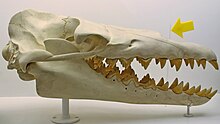
Back باسيلوصوريات Arabic Basilosàurids Catalan Basilosauridae Spanish خسروسوسماران Persian Basilosauridae French בסילוזאוריים HE Basilosauridae Croatian Basilosauridae Hungarian Basilosauridae ID Basilosauridae Italian
| Basilosauridae | |
|---|---|

| |
| Skull of the genus Saghacetus. | |
| Scientific classification | |
| Domain: | Eukaryota |
| Kingdom: | Animalia |
| Phylum: | Chordata |
| Class: | Mammalia |
| Order: | Artiodactyla |
| Infraorder: | Cetacea |
| Family: | †Basilosauridae Cope 1868[1] |
| Genera | |
|
See text | |
Basilosauridae is a family of extinct cetaceans. They lived during the middle to the early late Eocene and are known from all continents, including Antarctica.[1][2] They were probably the first fully aquatic cetaceans.[3][4] The group is noted to be a paraphyletic assemblage of stem group whales[5] from which the monophyletic Neoceti are derived.[6]
- ^ a b c Basilosauridae in the Paleobiology Database
- ^ Fostowicz-Frelik 2003
- ^ Uhen 2002
- ^ Buono M, Fordyce R.E., Marx F.G., Fernández M.S. & Reguero M. (2019). "Eocene Antarctica: a window into the earliest history of modern whales". Advances in Polar Science 30(3): p. 293-302. doi:10.13679/j.advps.2019.0005
- ^ Lloyd, G. T.; Slater, G. J. (2021). "A total-group phylogenetic metatree for Cetacea and the importance of fossil data in diversification analyses". Systematic Biology. 70 (5): 922–939. doi:10.1093/sysbio/syab002. PMID 33507304.
- ^ Davydenko, S.; Shevchenko, T.; Ryabokon, T.; Tretiakov, R.; Gol’din, P. (2021). "A Giant Eocene Whale from Ukraine Uncovers Early Cetacean Adaptations to the Fully Aquatic Life". Evolutionary Biology. 48 (1): 67–80. doi:10.1007/s11692-020-09524-8. S2CID 230110031.
© MMXXIII Rich X Search. We shall prevail. All rights reserved. Rich X Search